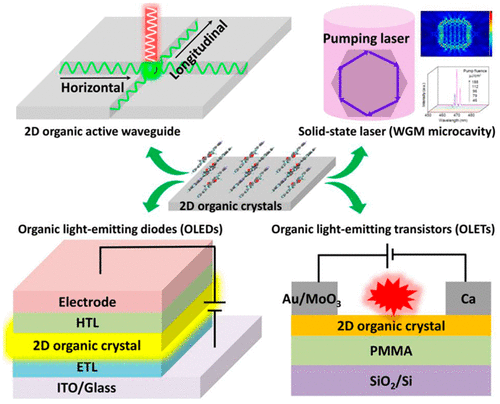当前位置:
X-MOL 学术
›
ACS Appl. Nano Mater.
›
论文详情
Our official English website, www.x-mol.net, welcomes your
feedback! (Note: you will need to create a separate account there.)
Two-Dimensional Organic Semiconductor Crystals for Photonics Applications
ACS Applied Nano Materials ( IF 5.3 ) Pub Date : 2020-02-14 , DOI: 10.1021/acsanm.0c00131 Ying-Li Shi 1 , Ming-Peng Zhuo 1 , Xue-Dong Wang 1 , Liang-Sheng Liao 1, 2
ACS Applied Nano Materials ( IF 5.3 ) Pub Date : 2020-02-14 , DOI: 10.1021/acsanm.0c00131 Ying-Li Shi 1 , Ming-Peng Zhuo 1 , Xue-Dong Wang 1 , Liang-Sheng Liao 1, 2
Affiliation

|
Two-dimensional (2D) organic crystals with significant advantages, such as high crystallinity, well-defined shape, and dimension-dependent optical properties, have been widely investigated in recent decades. At present, 2D organic crystals have been successfully applied to lasers, optical waveguides, organic light-emitting transistors, and organic light-emitting diodes. However, it is still a challenge for organic crystals to achieve controllable preparation, high charge mobility, and simultaneously efficient light emission because organic molecules mainly rely on noncovalent interactions (such as the van der Waals’ force and the hydrogen bonding). To introduce the superior characteristics and summary the huge breakthroughs of 2D organic crystals, we herein briefly review the recent progress in terms of growth strategies and potential applications in high-performance organic photonic devices and optoelectronic devices. In addition, we present our conclusion and expectation for the future development of 2D organic crystals.
中文翻译:

用于光子学应用的二维有机半导体晶体
二维(2D)具有显着优势的二维(2D)有机晶体,例如高结晶度,轮廓分明的形状以及尺寸依赖的光学特性,在最近几十年中已得到广泛研究。目前,二维有机晶体已成功应用于激光器,光波导,有机发光晶体管和有机发光二极管。然而,由于有机分子主要依赖于非共价相互作用(例如范德华力和氢键),因此有机晶体实现可控的制备,高电荷迁移率以及同时有效的发光仍然是一个挑战。为了介绍卓越的特性并总结2D有机晶体的巨大突破,我们在此简要回顾一下在高性能有机光子器件和光电器件中的增长策略和潜在应用方面的最新进展。另外,我们对二维有机晶体的未来发展提出了结论和期望。
更新日期:2020-02-14
中文翻译:

用于光子学应用的二维有机半导体晶体
二维(2D)具有显着优势的二维(2D)有机晶体,例如高结晶度,轮廓分明的形状以及尺寸依赖的光学特性,在最近几十年中已得到广泛研究。目前,二维有机晶体已成功应用于激光器,光波导,有机发光晶体管和有机发光二极管。然而,由于有机分子主要依赖于非共价相互作用(例如范德华力和氢键),因此有机晶体实现可控的制备,高电荷迁移率以及同时有效的发光仍然是一个挑战。为了介绍卓越的特性并总结2D有机晶体的巨大突破,我们在此简要回顾一下在高性能有机光子器件和光电器件中的增长策略和潜在应用方面的最新进展。另外,我们对二维有机晶体的未来发展提出了结论和期望。











































 京公网安备 11010802027423号
京公网安备 11010802027423号